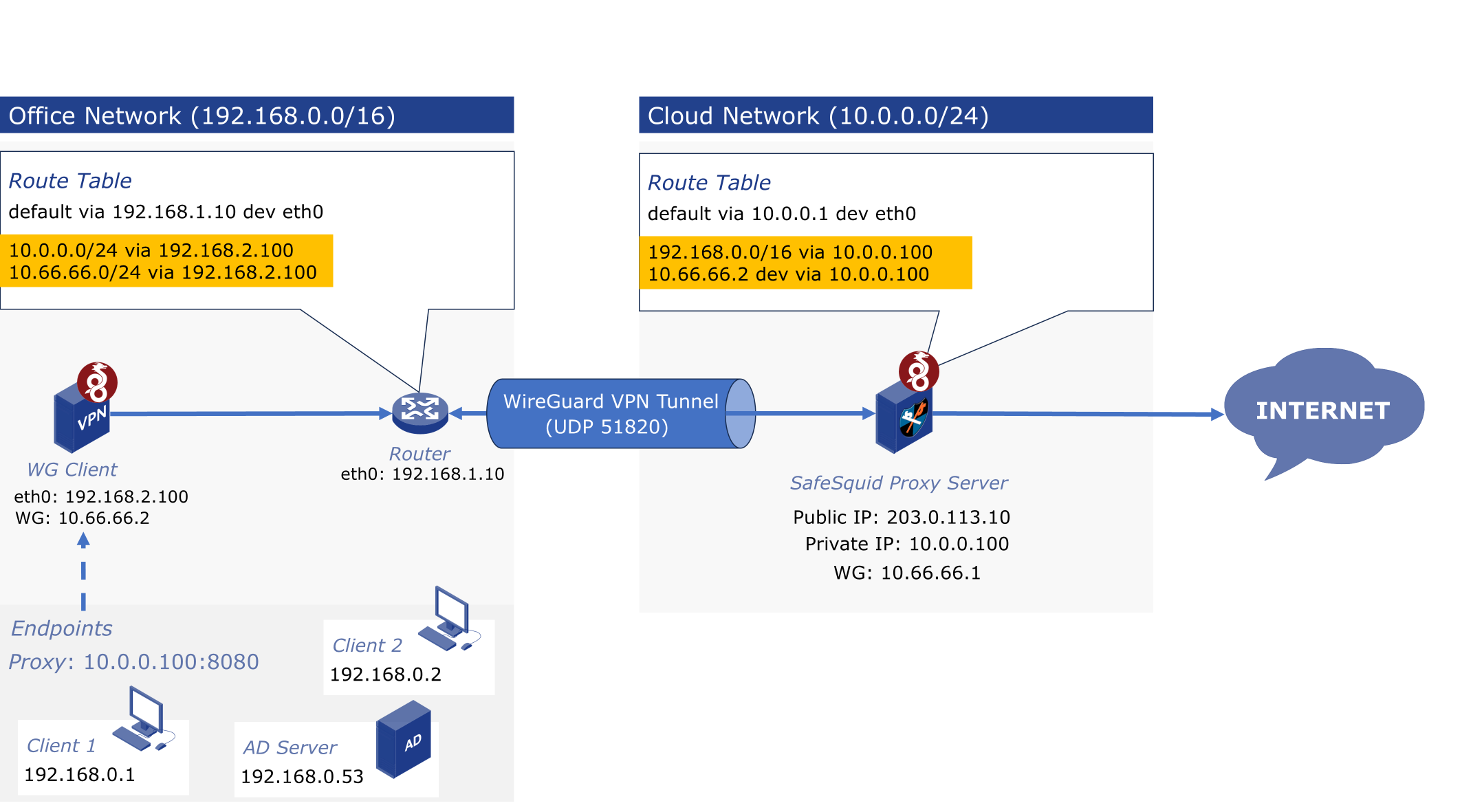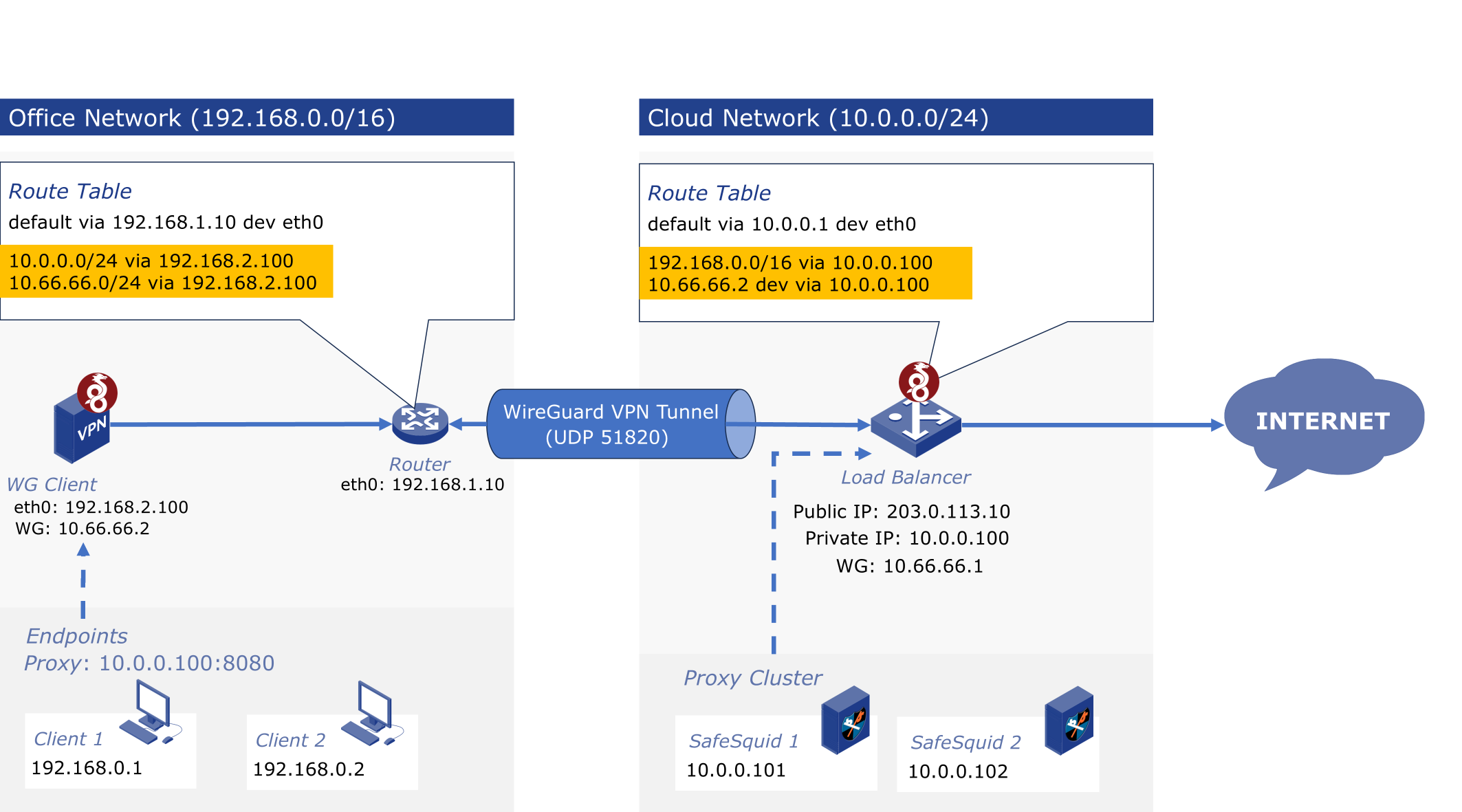VPN Integration
Directly exposing a SafeSquid proxy server hosted in the cloud to office or remote users is insecure and exposes critical infrastructure to external threats. Establishing a dedicated, encrypted WireGuard VPN tunnel enables secure transport of traffic from enterprise networks or remote endpoints to the cloud environment without public exposure. This configuration isolates the proxy server, limits attack surfaces, and enforces zero-trust connectivity using SafeSquid's application-layer inspection and access control mechanisms.
THe following diagram depicts the working of VPN tunnel:

Prerequisites
- Cloud VPS
- Office LAN or Remote Endpoint
Cloud VPS (WireGuard + SafeSquid Host)
- Ubuntu 24.04 LTS
- Public IPv4 address (e.g., 203.0.113.10)
- UDP port 51820 open in the cloud firewall
- Root or sudo privileges
- curl utility installed
Office LAN or Remote Endpoint (WireGuard Client)
- WireGuard installed
- Root or sudo-level access
- Access to client configuration files
- Internet connectivity to initiate outbound VPN tunnel
Network Topology Overview
- Cloud Environment
- Office Environment
| Element | Address | Description |
|---|---|---|
| Public IP | 203.0.113.10 | External IP of Cloud VPS |
| Private Subnet | 10.0.0.0/24 | Internal cloud network |
| WireGuard Server / SafeSquid Proxy IP | 10.0.0.100 | Internal IP of cloud VPS running WireGuard and SafeSquid |
| VPN Tunnel Subnet | 10.66.66.1/24 | IP pool for WireGuard interfaces |
| Element | Address | Description |
|---|---|---|
| Office Subnet | 10.200.2.0/24 | Internal network of office LAN |
| WireGuard Client1 IP | 10.200.2.100 | Office client behind NAT, initiates VPN tunnel to cloud |
| VPN Tunnel Subnet | 10.66.66.2/24 | IP pool for WireGuard interfaces |
Setup Procedure
1. Deploy WireGuard on Cloud VPS
Download Setup Script
Fetch the automated installation script provided by SafeSquid to simplify WireGuard server setup.
curl -O https://raw.githubusercontent.com/SafeSquid-Github/wireguard/refs/heads/main/wireguard-setup.sh
Execute Script
Run the script to initiate the WireGuard server configuration.
bash wireguard-setup.sh --install
During execution, provide:
- Public IP: 203.0.113.10
- Port: 51820
- VPN Subnet: 10.66.66.0/24
- Peer Name: Client1
Outputs:
- Server config: /etc/wireguard/wg0.conf
- Client config: /etc/wireguard/wg0-client-client1.conf
2. Install WireGuard on the Office Endpoint
Install WireGuard on the office client to enable VPN connectivity.
apt update
apt install wireguard -y
This provides the necessary tools: wg for tunnel management and wg-quick for service control.
3. Configure Office Endpoint
Retrieve Client Configuration from Server
Display the client configuration generated by the cloud-side script.
cat /etc/wireguard/wg0-client-client1.conf
Copy the output.
Save Configuration Locally
Create the required directory and apply the configuration on the office client.
mkdir -p /etc/wireguard
vim /etc/wireguard/wg0.conf
Paste the copied output from the previous step and save the file.
4. Set Peer Routing Rules
On Cloud VPS
Modify the peer section in wg0.conf to allow routing to the office subnet and the client's tunnel IP.
AllowedIPs = 10.66.66.2/32,10.200.2.0/24
- 10.66.66.2/32: IP assigned to Client1
- 10.200.2.0/24: Entire office LAN behind Client1
On Office Client
Ensure routing towards the server and internal cloud subnet.
AllowedIPs = 10.66.66.1/32,10.0.0.0/24
- 10.66.66.1/32: Server tunnel endpoint
- 10.0.0.0/24: Internal cloud LAN accessible via VPN
5. Restart and Enable Services
Cloud VPS
Restart the interface to apply changes and enable persistence at boot.
systemctl restart wg-quick@wg0
systemctl enable wg-quick@wg0
Office Client
Restart the VPN tunnel with updated config and ensure service autostarts.
wg-quick down wg0 && wg-quick up wg0
systemctl enable wg-quick@wg0
6. Enable IP Forwarding
Edit the system control file to enable IPv4 packet forwarding.
vim /etc/sysctl.conf
Uncomment or append:
net.ipv4.ip_forward = 1
Apply the new setting:
sysctl -p
7. Configure Routing
Cloud VPS Route
Route traffic destined for the office LAN via the WireGuard server's internal IP.
ip route add 10.200.2.0/24 via 10.0.0.100
This ensures cloud workloads can reach the office network securely via VPN.
Office Router Configuration
Direct cloud-bound traffic from office LAN through Client1 (WireGuard client).
ip route add 10.0.0.0/24 via 10.200.2.100
Guarantees LAN devices access cloud services routed through the VPN tunnel.
8. Enforce One-Way Tunnel Security
Block Unsolicited Traffic from Cloud to Office
Insert a firewall rule to drop unsolicited packets targeting the office subnet from the tunnel.
iptables -A FORWARD -i wg0 -d 10.200.2.0/24 -j DROP
Persist Firewall Rules Across Reboots
Install the persistence utility and save the current rule set.
apt install iptables-persistent -y
netfilter-persistent save
Validate VPN Connectivity
- Cloud VPS Ping Test
- Office Client Ping Tests
- Tunnel Status Inspection
Confirm tunnel and office endpoint reachability.
ping 10.66.66.2
ping 10.200.2.100
Ensure reverse reachability to server and cloud LAN.
ping 10.66.66.1
ping 10.0.0.100
Display active peers and session statistics.
wg show
Post-Deployment Considerations
1. Multi-Client Deployment (Office & Remote Users)
If you plan to support remote employees, not just a single office, you must:
On the WireGuard Server:
-
Generate separate peer configurations for each user or location.
-
Assign unique tunnel IPs to each client (e.g., 10.66.66.3/32, 10.66.66.4/32, etc.).
-
Use a separate AllowedIPs per peer.
Example server config for two clients:
[Peer]
Office LAN
PublicKey = OFFICE_PUBLIC_KEY
AllowedIPs = 10.66.66.2/32,10.200.2.0/24
[Peer]
Remote User1
PublicKey = REMOTE_USER1_KEY
AllowedIPs = 10.66.66.3/32
On the Remote User
- Use AllowedIPs = 0.0.0.0/0 if they want all their traffic routed through the VPN.
- Or use 10.0.0.0/24 if they only need access to internal cloud resources.
2. Directory Server Integration
SafeSquid requires directory services (e.g., Active Directory) for identity-based policy enforcement. Ensure:
- Proxy initiates LDAP/LDAPS requests from its WireGuard tunnel IP
- Directory server accepts and routes responses to VPN subnet (e.g., 10.66.66.1)
This guarantees seamless identity resolution and policy mapping inside the VPN-secured cloud perimeter.
3. Proxy Cluster with Centralized Load Balancer
When deploying multiple SafeSquid instances as a cluster:
- Place a central load balancer between the office VPN ingress and the proxy layer
- The load balancer handles all incoming WireGuard traffic
- Distributes requests to proxy nodes for inspection and filtering
- Routes sanitized output to the internet
The architecture shown in maintains performance, simplifies scale-out, and centralizes VPN and external access controls.

4. Key Pair Management
Each peer device must independently generate cryptographic keys:
wg genkey | tee privatekey | wg pubkey > publickey
- Only the public key is shared with the server.
- The private key is stored securely on the client system.
- Key rotation is recommended for long-term deployments.